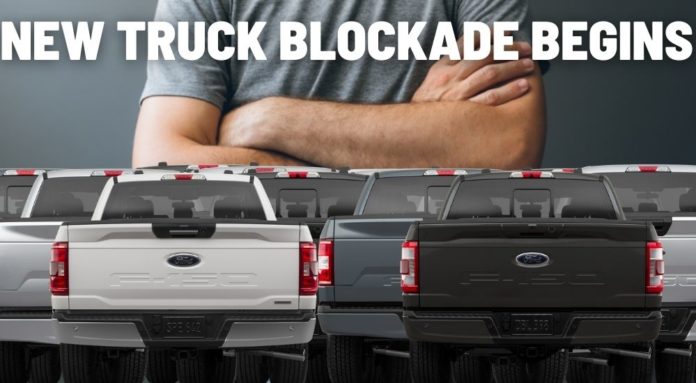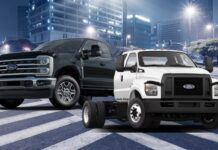Inspired by the recent demonstrations in Ottawa, a group of 2022 Ford F-150 owners have vowed to occupy a local intersection until their demands are met. While the Canadian protest was focused on big-rig truckers who refused to comply with the government’s vaccine mandate, the pickup protest has comparatively modest aims: they simply want people to recognize how cool their new trucks are.
Bearing signs including “Honk If You Like My Truck,” “Trucks R People 2,” and “Please Notice Me,” the protest started out small with the three drivers present unable to form any type of effective blockade. “There’s a lot of passion for this cause, don’t get me wrong, but it’s also 50 cent wing night at The Funky Chicken, so that’s divided some loyalties,” says Mark Simmons, protest organizer and top commenter on his local newspaper’s Facebook page.
Once the undisputed kings of the road, the humble American pickup has lost ground to the growing crossover SUV sector, which features many of the advantages of a pickup but offers improved efficiency thanks to their unibody construction method. An industry-wide shift to these smaller, more eco-conscious vehicles has some pickup drivers feeling left behind, and the recent introduction of hybrid and all-electric trucks hasn’t made things any easier.
“Used to be that owning a sweet truck was the end-all and be-all of human existence––at least in my town of 714 people––but they just don’t command the same respect they once did,” says Jeff Buckwalter, local stump grinder. “At this point, I’m getting dangerously close to having to develop an actual personality because apparently ‘owns a chromed-out pickup with the extreme off-road package’ just doesn’t cut it anymore,” he says.
In the past, Buckwalter had no problem turning heads whenever he upgraded to the newest model, turning heads all the way down main street and earning a few whistles of admiration along the way. These days, the pickup owner has to make do with the wide-eyed stares of the fourth-grade boys when he picks his daughter up from school. “That was keeping me going for a little bit, but then Henderson got a Tesla, and I can hardly get their attention without laying on the horn,” he says.
While many news outlets are content to paint the protesters as a backward artifact of toxic masculinity eager to pick a fight over any and every topic under the sun, many organizers disagree, saying that the relative cushiness of their lives is, in itself, its own sort of hardship. “It’s not easy. People with real problems probably go through each day paralyzed by feelings of impotence and quietly boiling rage, but I have to spend hours watching cable news to figure out what I should even be mad about,” says Buckwalter, holding a sign that reads “How About I CROSSOVER There and Kick Your Ass?”
Academics see a direct connection between the local demonstration and the recent flare-up in Canada’s capital, with both incidents representing an attention-seeking exercise from groups struggling to deal with marginalization for the first time.
“Psychologically, these two protests have a lot in common,” says Preet Singh, a psychology professor at Ottawa’s Carleton University. “They’re both gross overreactions to the slightest perceived hardship from a group of people who have never had to endure any real hardships. Reactions like the protest are to be expected, and perhaps should even be encouraged lest these groups let it build up and do something silly like elect a sociopathic grifter into a position of power,” he says.












